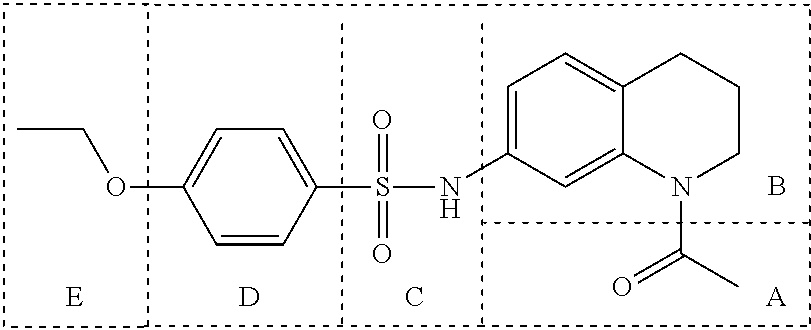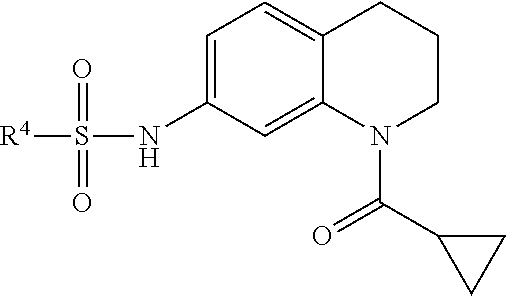Inhibitors of Base Excision Repair Activity and Therapeutic Methods Based Thereon
a technology of base excision and repair activity, which is applied in the direction of organic chemistry, organic active ingredients, drug compositions, etc., can solve the problems of double strand breakage and harm to cell growth
- Summary
- Abstract
- Description
- Claims
- Application Information
AI Technical Summary
Benefits of technology
Problems solved by technology
Method used
Image
Examples
example 1
rocedure for OGG1 Inhibitor Assay
[0217]Background: OGG1 is used in base excision repair (BER) of DNA; specifically, OGG1 excises 8-OG from DNA. An assay to measure the activity of OGG1 allows for the ability to measure the inhibitory properties of inhibitors in accordance with various embodiments.
[0218]Methods: Synthesized compounds and hOGG1 (100 nM) were incubated in NEBuffer 4 (1×) with BSA (1×) at 37° C. (15 min) in 100 μL reaction volumes in a black 96-well plate. (See, e.g., Edwards, S. K., et al., ChemBioChem 2015, 16, 1637-1646, the disclosure of which is incorporated herein by reference.) After that, OGR1 (1.2 μM) was added to the reaction mixture. Fluorescence at 460 nm was measured on a Thermo Fluoroskan Ascent FL fluorescence plate reader (λex=355 nm). The slope of initial rate (12 min) was calculated, and % of control was used for inhibition activity. BSA, hOGG1 and NEBuffer 4 were purchased from New England Biolabs and used. UltraPure Distilled Water (Invitrogen) was p...
example 2
for MTH1 Assay
[0220]Background: MTH1 is a DNA repair enzyme with similar properties of OGG1. An experiment to measure the effect of inhibitors in accordance with certain embodiments against MTH1 demonstrates the specificity for OGG1 of inhibitors in accordance with certain embodiments.
[0221]Methods: Compound 41 and MTH1 (500 nM) were incubated in 21.8 μL reaction volume PNK buffer (1×) solution of ARGO probe (ATP-linked chimeric nucleotide) (40 μM) at 30° C. (30 min). After that, 5 μL of this reaction solution was mixed with 20 μL of Kinase-Glo. Immediately, luminescence was measured on a Thermo Fluoroskan Ascent FL fluorescence plate reader. (See, e.g., Ji, D., et al., J. Am. Chem. Soc. 2016, 138, 9005-9008, the disclosure of which is incorporated herein by reference.) The slope of initial rate (6 min) was calculated, and % of control was used for inhibition activity. MTH1 was purchased from Abcam, PNK buffer was purchased from New England Biolabs, and Kinase-Glo was purchased from...
example 3
for NUDT16 Assay
[0224]Background: NUDT16 is a DNA repair enzyme with similar properties of OGG1. An experiment to measure the effect of inhibitors in accordance with certain embodiments against NUDT16 demonstrates the specificity for OGG1 of inhibitors in accordance with certain embodiments.
[0225]Methods: The standard 20 μL reaction contained: 50 mM Tris-HCl, 50 mM MgCl2, 1 mM DTT, pH 8.5, 100 μM DUAL nucleotide, 10 nM NUDT16 and compound 41. After 1 h incubation at 37° C., 5 μL of this reaction solution was added to 20 μL Kinase-Glo Luminescent Kinase Assay reaction solution (prepared as instructed for the ATP determination kit) in a 96 well plate. The bioluminescence signal was recorded at 1 min intervals over 10 min.
[0226]Results: As illustrated in FIG. 11, NUDT16 possessed ˜70% enzyme activity in the presence of the inhibitor, indicating that the inhibitor has minimal inhibitory effect on NUDT16.
[0227]Conclusion: Compound 41 shows low inhibitory effect on NUDT16.
PUM
| Property | Measurement | Unit |
|---|---|---|
| volumes | aaaaa | aaaaa |
| volume | aaaaa | aaaaa |
| pH | aaaaa | aaaaa |
Abstract
Description
Claims
Application Information
 Login to View More
Login to View More - Generate Ideas
- Intellectual Property
- Life Sciences
- Materials
- Tech Scout
- Unparalleled Data Quality
- Higher Quality Content
- 60% Fewer Hallucinations
Browse by: Latest US Patents, China's latest patents, Technical Efficacy Thesaurus, Application Domain, Technology Topic, Popular Technical Reports.
© 2025 PatSnap. All rights reserved.Legal|Privacy policy|Modern Slavery Act Transparency Statement|Sitemap|About US| Contact US: help@patsnap.com



